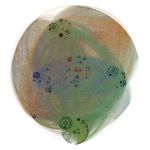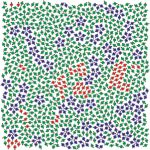News
EPJ Data Science Highlight - Tracking gene flow in marine plant evolution
- Details
- Published on 20 December 2012

Physicists and biologists apply Big Data statistical tools to study marine plant evolution
A new method that could give a deeper insight into evolutional biology by tracing directionality in gene migration has just appeared in EPJ Data Science. Paolo Masucci from the Centre for Advanced Spatial Analysis, at University College of London, UK, and colleagues identified the segregation of genes that a marine plant underwent during its evolution. They found that the exchange of genes, or gene flow, between populations of a marine plant went westward from the Mediterranean to the Atlantic. This methodology could also be used to estimate the information flow in complex networks, including other biological or social networks.
EPJ C Highlight - Curvature Oscillations in Modified Gravity Theories as Possible Source of Ultra-High-Energy Cosmic Rays
- Details
- Published on 07 December 2012
The origin of ultra-high-energy cosmic rays, with energies around the GZK cutoff, remains an unsolved mystery. In the present letter a novel and intriguing explanation is suggested that links far-reaching fundamental aspects of F(R) modified theories to an efficient production of highly energetic cosmic rays during the recent history of the Universe.
At the core of this work lies the proof that in cosmological and astrophysical systems with rising energy densities, the F(R) modified theories of gravity exhibit powerful oscillations of the curvature scalar R, with an amplitude much larger than the standard value of curvature predicted by the General Relativity. These oscillations are strongly anharmonic, with frequencies that can be as large as billions of GeV. This striking and rather unexpected oscillatory behavior of R lends support to the idea that ultra-high energy cosmic rays can be generated by such curvature oscillations at the appropriate cosmological redshifts.
Curvature oscillations in modified gravity and high energy cosmic rays. E.V. Arbuzova, A.D. Dolgov, L. Reverberi (2012), European Physical Journal C 72:2247, DOI 10.1140/epjc/s10052-012-2247-z
EPJ D Colloquium – An accurate method to measure scattering non-perturbatively
- Details
- Published on 26 November 2012

Atomic and molecular collisions occurring at low impact energies and for neutral targets need adequate methods for accurately measuring their scattering properties. Such measures are fundamental to the description of the dynamics of plasmas and provide insight into the long-range Coulomb interactions between charged particles. In the last twenty years many novel non-perturbative approaches have been applied. The time-dependent close-coupling (TDCC) approach, discussed in this EPJD Review, differs fundamentally from previous non-perturbative approaches in that it solves the time-dependent, rather than time-independent, Schr¨odinger equation. This Review provides a detailed description of the application of the time-dependent close-coupling approach to ionising collisions of electrons, photons and ions with small atoms and molecules.
EPJ D Highlight - Bringing measuring accuracy to radical treatment
- Details
- Published on 13 November 2012

Significant progress made in evaluating the density of active species used in medical applications of plasma physics could improve the accuracy of treatment
An international team of scientists working at the Plasma Technology research unit at Ghent University, Belgium, has determined for the first time the absolute density of active substances called radicals found in a state of matter known as plasma, in a study just published in EPJ D. These findings could have important implications for medicine—for example, for stimulating tissue regeneration, or to induce a targeted antiseptic effect in vivo without affecting neighbouring tissues.
Hyperlinked references
- Details
- Published on 13 November 2012
EPJ Web of Conferences now provides online references, which are directly linked to the cited articles, via CrossRef. This allows the readers to move from one article to another at the citation level, regardless of journal or publisher.
EPJ Web of Conferences also provides a citation tracking system.
EPJ Web of Conferences adopts the Creative Commons Attribution License
- Details
- Published on 13 November 2012
Up to now, EPJ Web of Conferences contents were published under the Creative Commons Attribution Non-Commercial license. We are pleased to announce that the journal won’t restrict the commercial use of its contents any more. As a result, all open access contents at EPJ Web of Conferences will be published under the Creative Commons Attribution license, which permits unrestricted use, distribution, and reproduction in any medium, provided the original work is properly cited. The copyright will remain with the authors.
EPJ Web of Conferences now indexed in DOAJ and NASA ADS
- Details
- Published on 13 November 2012
EPJ Web of Conferences is now indexed in the Directory of Open Access Journals (DOAJ) and NASA Astrophysics Data System (ADS).
- Directory of Open Access Journals (DOAJ) covers free, full text, quality controlled scientific and scholarly journals.
- NASA Astrophysics Data System (ADS) is a Digital Library portal for researchers in Astronomy and Physics.
EPJ Web of Conferences indexed in CAS, Inspec and Web of Science
- Details
- Published on 13 November 2012
EPJ Web of Conferences is indexed in the Chemical Abstracts Service (CAS), Inspec and Conference Proceedings Citation Index (Web of Science) bibliographic databases.
- Chemical Abstracts Service (CAS) monitors, indexes, and abstracts the world's chemistry-related literature and patents. These databases offer many scientific disciplines, including chemistry, biomedical sciences, engineering, materials science, physics, and more.
- Inspec is the IEE's comprehensive index to literature in physics, electrical/electronic technology, computing, control engineering and information technology.
- Conference Proceedings Citation Index accessed via Web of Science, helps researchers access the published literature from the most significant conferences, symposia, seminars, colloquia, workshops, and conventions worldwide.
EPJ Data Science Highlight - Driven by friendship
- Details
- Published on 11 November 2012

Dynamics of Facebook: the structure of the network drives friends to congregate into many small, highly interconnected communities
For the first time, the dynamics of how Facebook user communities are formed have been identified, revealing surprisingly few large communities and innumerable highly connected small-size communities. These findings are about to be published in EPJ Data Science by Italian scientist Emilio Ferrara, affiliated with both Indiana University in Bloomington, Indiana, USA and his home University of Messina. This work could ultimately help identify the most efficient way to spread information, such as advertising, or ideas over large networks.
EPJ E Colloquium - Hidden order in the liquid phase
- Details
- Published on 05 November 2012

A two-order parameter model proposed to describe water-like anomalies, liquid-liquid transition, glass transition, crystal nucleation and quasicrystal formation within the same framework.
The liquid state of matter is far from being a perfectly disordered homogeneous state. In a Colloquium paper published in EPJ E, Hajime Tanaka argues that to achieve a better understanding of liquids, it is crucial to recognize that a liquid has a general tendency to exhibit local structural order, and that this order is intrinsic and universal to any liquid. In other words, there is a need for a new order parameter describing a low local free-energy configuration (this is a bond-orientational order parameter in many cases), in addition to a density order parameter.





